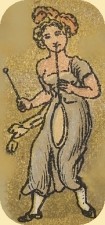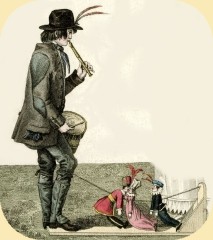some Regency Folk Customs
involvingthe pipe and tabor
researched by Frances
From the early 1800's onwards middle-class writers were starting to record rural traditions and customs; they realised that country life was changing and the old ways were dying out.
Joseph Strutt quotes from many older documents. Illustrations from the 1838 edition include 'a cock dancing on stilts to the pipe and tabor, a' 14th century pipe and tabor player with an animal with horns and 'a horse dancing to the pipe and tabor'.
(source: 'Sports and Pastimes of the People of England from the earliest period', original 1801, 2nd ed.1903)
Country customs involving the pipe and tabor were recorded as including:
Plough Monday 1817
"Sherwood Forest is a region that still retains much of the quaint customs and holiday games of the olden time. .. These rude pageants are the lingering remains of the old customs of Plough Monday, when bands of rustics, fantastically dressed, and furnished with pipe and tabor, dragged what was called the "fool plough" from house to house, singing ballads and performing antics, for which they were rewarded with money and good cheer. ...Critics who reside in cities have little idea of the primitive manners and observances, which still prevail in remote and rural neighborhoods."
source: 'Abbotsford and Newstead Abbey' by Washington Irving,1783-1859)
Jack-in-the-Green on May Day 1819"In London there are, and have long been, a few forms of May-day festivity in a great measure peculiar. The day is still marked by a celebration, well known to every resident in the metropolis, in which the chimney-sweeps play the sole part. What we usually see is a small band, composed of two or three men in fantastic dresses, one smartly dressed female glittering with spangles, and a strange figure called Jack-in-the-green, being a man concealed within a tall frame of herbs and flowers, decorated with a flag at top. All of these figures or persons stop here and there in the course of their rounds, and dance to the music of a drum and fife , expecting of course to be remunerated by halfpence from the onlookers. It is now generally a rather poor show, and does not attract much regard;"
source: ' The Sketch Book of Geoffrey Crayon, Gent' by Washington Irving (1783 - 1859)
more examples of Jack-in-the-Green processions
Harvest Home
John Prescott Knight (1803-1881) painted the 'Harvest Home Evening' . The 1837 Liverpool exhibition catalogue described the painting:"The last load is brought in and stops under the village maypole which has been decorated for the occasion. The harvest queen advances accompanied by the cheerful pipe and tabor " .
Rowlandson, generally noted for his satires, drew 'The Harvest Home' procession with a girl playing the pipe and tabor as one in a series depicting typical English life situations.
Whitson Ale 1826
May 23. "The modern Whitson Ale consists of a lord and lady of the ale, a steward, sword-bearer, purse-bearer, mace-bearer, train-bearer, or page, fool, and pipe and tabor man, with a company of young men and women, who dance in a barn."
'The Every-Day Book' by William Hone, 1825-1826
The Every-Day Book included accounts and anecdotes drawn from antiquarian lore and literature that Hone had discovered in his decades of research in the British Library and in his work in the antiquarian book trade. So it is now not easy to sort out what was contemporary reporting, and what historical information.
[Ales were one of the principal sources of income for the local church, and particularly for the guilds which contributed in various ways to parish life. An ale was more than the barrel of hearty cheer that it took its name from. An ale was a kind of parish supper or picnic, generally with entertainment and often with various wares for sale either for the benefit of the parish or for the benefit of the vendor. The parish or guild that sponsored the event provided the ale, charging for each tankard, of course. Most parishes had certain fixed occasions when they would put on an ale, and there were also ales for special events, such as weddings, whence we get the term bridal , i.e. "bride-ale". One of the most popular and widely observed occasions for an ale was at Whitsun. source]
Milkmaids Procession
1825 The 'Mayer's Song a composition, or rather a medley, of great antiquity'"In London, thirty years ago,
When pretty milkmaids went about,
It was a goodly sight to see
Their May-day Pageant all drawn out:-Themselves in comely colours drest,
Their shining garland in the middle,
A pipe and tabor on before,
Or else the foot-inspiring fiddle.They stopt at houses, where it was
Their custom to cry "milk below!"
And, while the music play'd, with smiles
Join'd hands, and pointed toe to toe. ... "from: May 1, 'Every-Day Book', Hone
Dancing Bear
In 1851 Henry Mayhew undertook a ground-breaking survey of the poor of London. He interviewed Londoners about how they made a living. One was a 'street-musicianer' who talked to Mayhew about what he did 30 years before. :"A stout, reddish-faced man, who was familiar with all kinds of exhibitions, and had the coaxing, deferential manner of many persons who ply for money in the streets, gave me an account of what he called ' his experience ' as the drum and pipes ....."I''ve played with Michael, the Italy Bear. I've played the fife and tabor with him. The tabor was a little drum about the size of my cap, and it was tapped with a little stick"
'London Labour and the London Poor', 1851 by Henry Mayhew (1812 - 1887)
Jig dolls
There are drawings of itinerant pipe and tabor players with 'jig dolls' that were popular street entertainments across Europe. Also known as Marionnettes-a-la-planchettes or Les Petites Marionnettes, they were loose limbed dolls that danced on a vibrating platform as the entertainer tapped a foot. It is reputed that they came to England from Italy. This example is from a fashion plate published in 1815:
Morris Dancing
Many villages still had traditional morris dancing sides.As a child Sir George Gilbert Scott (1811-1878) lived in Gawcot village, Buckinghamshire. In 1827 he moved to London to become an architect associated with the design, building and renovation of churches, cathedrals and workhouses. Writing about his childhood:
"The Morris dancers were young men perhaps about a dozen in number. ...In their hands were short 'white wands'
& they danced to the 'pipe and tabour'... I well remember My intense admiration of their skill. The noise of the dozen wands keeping time with the tabour and of the jingling bells also roughly following the tune added to the lively antics"(source: London, British Architectural Library, Manuscripts and Archives Collection, Sir George Gilbert Scott Papers, Sc GGS/3, notebook 1, 'Personal & Professional Recollections', f. 27, written 22 January 1864; published in Recollections of Nineteenth century Buckinghamshire, p.18)
at Bampton in the Cotswolds:
" Thomas Radband (1776-1854), had played them around the turn of the eighteenth century;
the pipe and tabor player, 'poor old Master Beechey, of Lew', who had played at Bampton early in the century."(source: Article MT051, Musical Traditions)
at Spelsbury in Oxfordshire:
"Spelsbury Morris (around 1820's) was a set of women Morris Dancers who used to dance on Whit Monday. They were mostly farmers daughters, girls of 18-20, and were under the escort of a man who looked after them. ..... With them went a clown or "squire" with bladders or cow's tail and a man playing the pipe and tabour."
(source: John Corbett, 88, of Spelsbury Aug 1894, The Morris Ring Archive - Cecil Sharp Folk Dance Notes)
Gutch writing in 1847says that, a few years before, he witnessed
" a numerous retinue of morris-dancers, remarkably well habited, skilfully performing their evolutions to the tune of a tabor and pipe in the streets of Oxford University"
in a chapter called The Morris Dancers:
p 143 "These eighteen persons, the fiddlers, the taborer, the wifflers" (?)
p145 "hold taborer"quoted in: 'Rush-Bearing : An Account of the Old Custom of Strewing Rushes, Carrying Rushes to Church;
The Rushcart; Garlands in Churches; Morris Dancers; The Wakes; The Rush'. by Alfred Burton
The pipe and tabor of John Fathers (1789-1873) born at Upper Heyford, Oxfordshire, had a sticky end:
"He Played the Whittle and Dub for the different Morris round about - the wife of his son .. told me that she gave her Children the Whittle and Dub to Play with and she remembers them Breaking them to Pieces."
Hertfordshire morris-dancers performed in London in 1826:
" They consisted of eight young men, six of whom were dancers, the seventh played the pipe and tabor, and the eighth, the head of them, collected the pence in his hat "
Hone (1780 - 1842) 'The Every-Day Book' .
Morris dancers and pipe and tabor players also appeared in contemporary literature: 1826
"Were you now, in your bodily self, to light suddenly on a Maypole, with all the blithe morris-dancers prancing around it to the merry pipe and tabor, with bells jingling, ribands fluttering, lads frisking and laughing, lasses leaping"
'Woodstock' by Sir Walter Scott (1771 - 1832)
Sir Walter Scott, who was Scottish and had an interest in old Border tales and ballads, understood the place that the pipe and tabor had in the lives of English people when he wrote in 1816:
"instead of giving way to the terrors of authority; and the youth of both sexes, to whom the pipe and tabor in England, or the bagpipe in Scotland, would have been in themselves an irresistible temptation .. "
top of page


